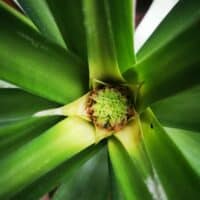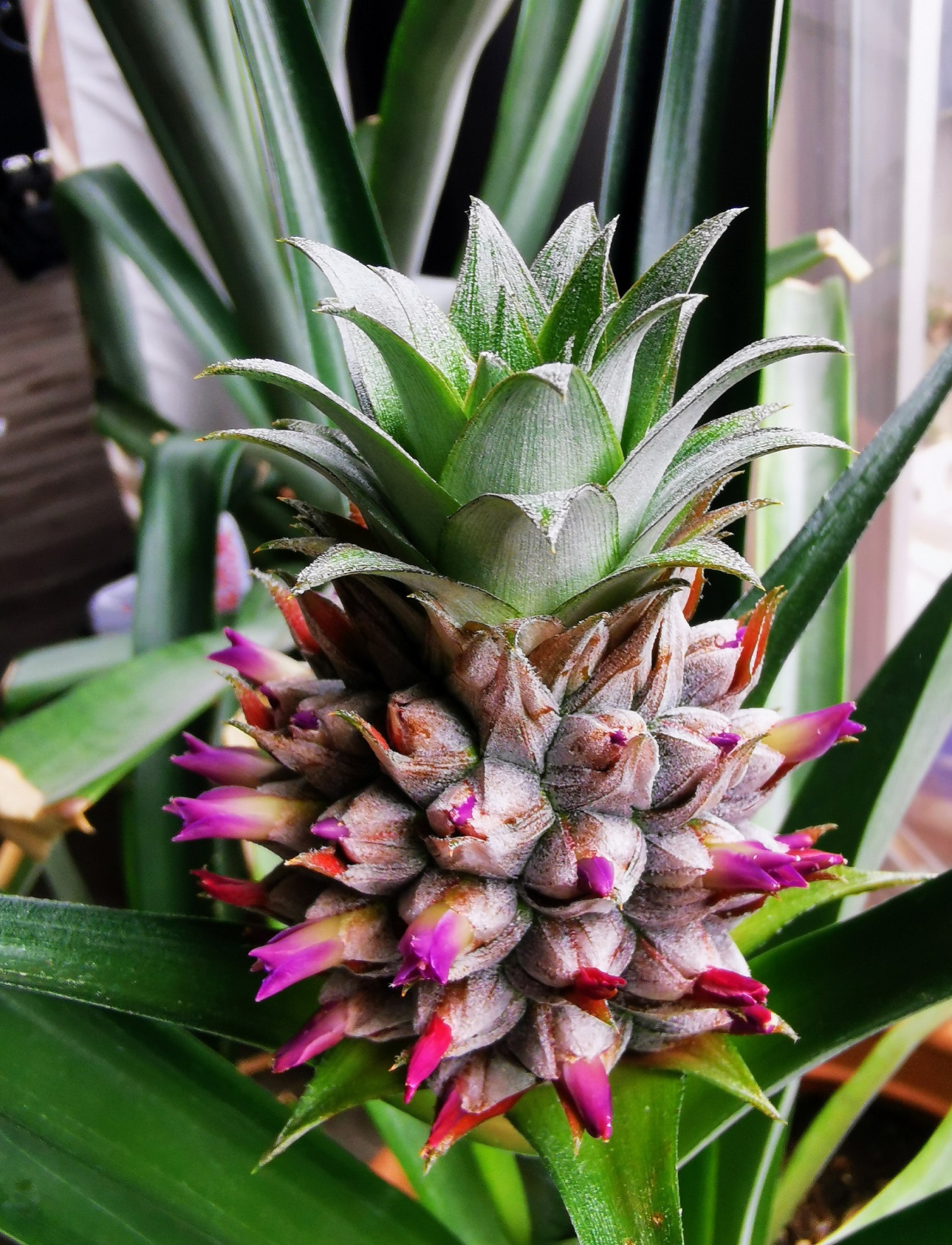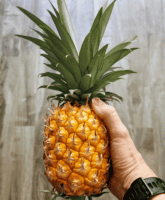Pineapples growing on our North Shore
June 8, 2023
There is a sunny window on the North Shore that is brimming with pineapples, plumeria and bougainvillea. Perhaps more typically found in Hawaii, the mini garden is finally bearing fruit in Lynn Valley.
Mini-farm
LynnValleyLife.com’s own Robin Thorneycroft has been growing pineapple plants in Lynn Valley for nine years. “It was an experiment to see what happens, I could never quite get avocado pits to take off, so one day I thought to try a pineapple,” she said. “Frankly, we had young kids and just bought a home - money was tight. I liked the idea of a “free” plant.”From one little plant rooting in water, the family now has six pineapple plants in various stages of maturity and this time last year there was a small big surprise.“Without question, with a harvest of two so far, I think we are the premier pineapple farmers of North Vancouver. We had always assumed that these would just be some greenery in our living room,” said Thorneycroft. “Last year, I was watering the largest of the pineapples - its leaves are about 90 cm long - and noticed in the centre there was a teeny, tiny pineapple growing.”
“It was an experiment to see what happens, I could never quite get avocado pits to take off, so one day I thought to try a pineapple,” she said. “Frankly, we had young kids and just bought a home - money was tight. I liked the idea of a “free” plant.”From one little plant rooting in water, the family now has six pineapple plants in various stages of maturity and this time last year there was a small big surprise.“Without question, with a harvest of two so far, I think we are the premier pineapple farmers of North Vancouver. We had always assumed that these would just be some greenery in our living room,” said Thorneycroft. “Last year, I was watering the largest of the pineapples - its leaves are about 90 cm long - and noticed in the centre there was a teeny, tiny pineapple growing.” While Thorneycroft had considered it was possible to have the pineapple fruit after they were well established, she hadn’t taken any of the steps typically needed to trigger the fruiting process. “It was such a great surprise,” she said. “It took so long for the plant to produce a fruit we had no idea how long it would take for the fruit to mature.”The answer: about six months over the summer for the first. The second pineapple which fruited last October took even longer. The winter seemed to slow down the process even more - taking more than eight months. Most unexpected were the beautiful magenta flowers that are part of the pineapple fruit, said Thorneycroft.“This is something we have been playing by ear,” said Thorneycroft. “We could have maybe helped it along by creating a greenhouse. Our second pineapple really needed sun. Once we got the warm spell in late April it went from hard and dark green to bright yellow in about three days.”
While Thorneycroft had considered it was possible to have the pineapple fruit after they were well established, she hadn’t taken any of the steps typically needed to trigger the fruiting process. “It was such a great surprise,” she said. “It took so long for the plant to produce a fruit we had no idea how long it would take for the fruit to mature.”The answer: about six months over the summer for the first. The second pineapple which fruited last October took even longer. The winter seemed to slow down the process even more - taking more than eight months. Most unexpected were the beautiful magenta flowers that are part of the pineapple fruit, said Thorneycroft.“This is something we have been playing by ear,” said Thorneycroft. “We could have maybe helped it along by creating a greenhouse. Our second pineapple really needed sun. Once we got the warm spell in late April it went from hard and dark green to bright yellow in about three days.”Compost pile rescue
Growing pineapples from food waste is pretty easy, she said. “When shopping for your pineapple choose one that still has its green leaves in good condition,” said Thorneycroft. “When you want to eat it, carefully twist off the top. Next, peel off a few leaves to reveal the base and place it in a glass with the white fibres immersed in water.” With frequent water changes the top will develop roots that can then be planted as a houseplant. “The plants have been around the house for so long, they have names - Spike was our first and Prickles our second,” she said. “It does feel a bit weird to say Spike was delicious but it really was. They have not been the biggest pineapples but they have been the most aromatic. Just like homegrown tomatoes, there is a big difference when picking one at the height of ripeness and eating it moments later, compared to getting one from the store that was picked weeks before it was fully ripe and then endured shipping across the world.” Much of the advice for growing pineapples focuses on more southern parts of the US - suggesting it takes about three years to go from grocery store top to next-generation fruit harvest. Last year, a grower in the Yukon shared their approach. “This isn’t about food security or trying to be self-sufficient,” said Thorneycroft. “It’s more about bringing a little bit of the Maui to our dark winters. We now have plumeria and bougainvillea growing alongside the pineapples to bring a bit of an indoor tropical vibe.” She said her next goal is to get the plumeria to bloom and to see if their first pineapple will produce fruit after replanting its top - in about six more years.
With frequent water changes the top will develop roots that can then be planted as a houseplant. “The plants have been around the house for so long, they have names - Spike was our first and Prickles our second,” she said. “It does feel a bit weird to say Spike was delicious but it really was. They have not been the biggest pineapples but they have been the most aromatic. Just like homegrown tomatoes, there is a big difference when picking one at the height of ripeness and eating it moments later, compared to getting one from the store that was picked weeks before it was fully ripe and then endured shipping across the world.” Much of the advice for growing pineapples focuses on more southern parts of the US - suggesting it takes about three years to go from grocery store top to next-generation fruit harvest. Last year, a grower in the Yukon shared their approach. “This isn’t about food security or trying to be self-sufficient,” said Thorneycroft. “It’s more about bringing a little bit of the Maui to our dark winters. We now have plumeria and bougainvillea growing alongside the pineapples to bring a bit of an indoor tropical vibe.” She said her next goal is to get the plumeria to bloom and to see if their first pineapple will produce fruit after replanting its top - in about six more years. Looking for more?
There's always something fun and exciting happening in Lynn Valley. Check out our Community Events Calendar or learn more about Local Activities, Mountain Biking or Hiking and Walking Trails.Looking for more?
Related News
Community Calendar
-
Dec 161:00 PM - 2:30 PMLynn Valley Library 1277 Lynn Valley Rd, North Vancouver BC V7J 0A2, Canada
-
Dec 17
Lynn Valley Legion General Meeting
6:30 PM - 7:30 PMRoyal Canadian Legion, 1630 Lynn Valley Rd, North Vancouver, BC V7J 2B4, Canada -
Dec 18
Hot Cocoa with a Youth Worker
3:30 PM - 4:15 PMLynn Valley Library 1277 Lynn Valley Rd, North Vancouver BC V7J 0A2, Canada -
Dec 19
Meat Draw and 50/50
6:30 PM - 8:30 PMRoyal Canadian Legion Branch 114, 1630 Lynn Valley Rd, North Vancouver, BC V7J 2B4, Canada






